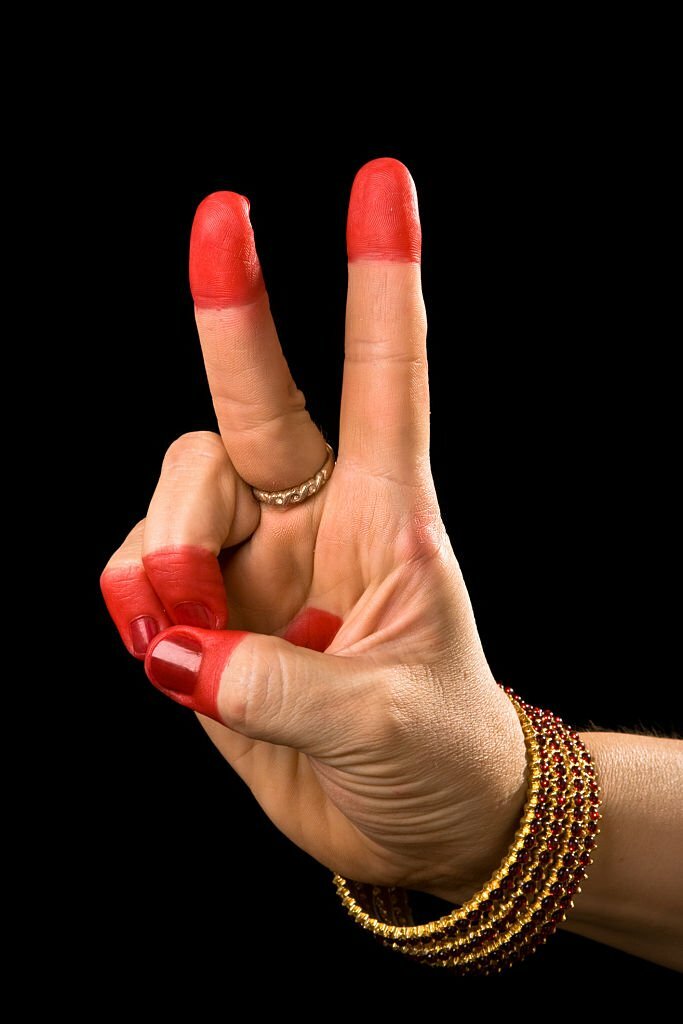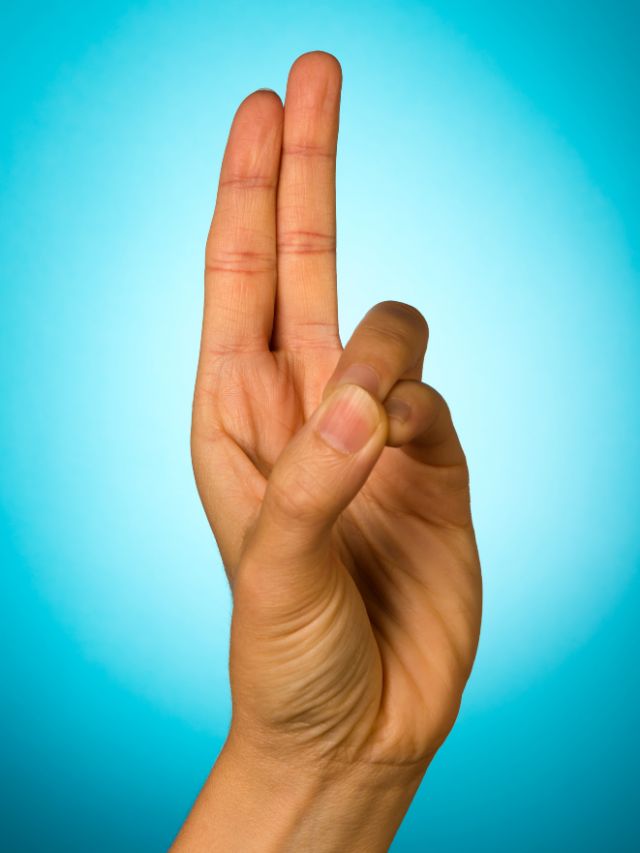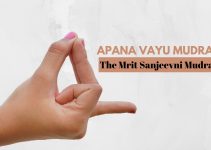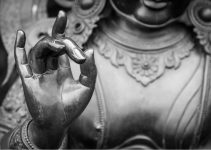
Kartarimukha Mudra, or Kartari Mudra, is a simple yet powerful yoga hand gesture to help calm the mind and bring about a sense of balance. The name comes from the Sanskrit words ‘Kartari’, meaning ‘scissors’, and ‘Mukha’, meaning ‘face’ or ‘mouth’. This mudra is all about cutting through mental noise and finding clarity in our thoughts.
While Kartarimukha Mudra is also seen in classical Indian dance, its benefits in yoga are vast, helping to improve focus, reduce stress, and create a sense of inner peace. In this article, we’ll take a closer look at how to perform this mudra, explore its benefits, and learn how it can enhance your yoga practice.
What is Kartarimukha Mudra?
At its core, Kartarimukha Mudra is about creating a specific hand gesture with your hands. You bring your ring and little fingers towards your palm, pressing them down with your thumb. Meanwhile, your index and middle fingers stay straight and stretched to form like a scissor shape. It’s like making a pair of scissors with your fingers, which is where the name ‘Kartari’ (scissors in Sanskrit) comes from.
The Symbolism Behind the Gesture
The scissor-like shape you create with your hands in Kartarimukha Mudra isn’t just for show. It’s a powerful symbol. Think about what scissors do: they cut. In the same way, this mudra is all about cutting through the mental clutter, helping you break free from unnecessary thoughts and find clarity.
This mudra is deeply connected to the principles of yoga. It’s about finding balance, creating a sense of inner calm, and preparing your mind for meditation. By practicing Kartarimukha Mudra, you’re embracing the yogic journey towards a more mindful and centered life.
Prana Mudra and Kartarimukha Mudra

Prana Mudra and Kartarimukha Mudra do have similarities in their hand gestures, but they are not exactly the same.
Prana Mudra
In Prana Mudra, you touch the tips of the ring and little fingers to the tip of the thumb, while the index and middle fingers remain extended straight. This mudra is believed to activate the Prana (vital life force energy) within the body, improve vitality, reduce fatigue, and boost the immune system.
Kartarimukha Mudra
On the other hand, Kartarimukha Mudra involves pressing the ring and little fingers towards the palm with the thumb, while keeping the index and middle fingers extended straight, forming a scissor-like shape. This mudra is used for calming the mind, improving focus, and bringing about a sense of balance.
While both mudras involve the ring and little fingers, the positioning of the fingers and the thumb is different, leading to different effects and uses in yoga and dance. Prana Mudra is more focused on enhancing life force and energy, whereas Kartarimukha Mudra is centered around mental clarity and balance.
Also read: How to Increase Prana Energy?
How to Perform Kartarimukha Mudra
Practicing Kartarimukha Mudra is straightforward, making it accessible for all practitioner. Here’s a step-by-step guide to help you perform this mudra correctly and safely.
Before you start, find a quiet and comfortable place to sit or stand. Make sure your body is relaxed, and your mind is calm. You can sit cross-legged on the floor, on a cushion, or in a chair with your feet flat on the ground. Keep your back straight and shoulders relaxed.
- Start with Open Hands: Begin with your hands open and your fingers extended, palms facing up.
- Fold the Fingers: Gently fold your ring and little fingers towards your palm.
- Secure with the Thumb: Press down on these two fingers with your thumb, creating a light but firm pressure.
- Extend the Other Fingers: Keep your index and middle fingers straight and extended, pointing away from your body.
- Hold and Breathe: Hold this hand gesture and take deep, steady breaths. Focus on your breath and feel the sense of calm spreading through your body.
Time & Duration
Kartarimukha Mudra can be practiced at any time of the day, but for enhanced concentration and tranquility, early morning or late evening are considered ideal. During these times, the environment is generally quieter, and the mind is more receptive to the calming effects of the mudra.
For beginners, it is recommended to hold Kartarimukha Mudra a shorter duration of about 5-10 minutes and gradually increase the time as your comfort and endurance improve. With consistent practice, you may extend the duration to 15-20 minutes or longer, depending on your individual needs and response to the mudra.
Benefits of Kartarimukha Mudra
Kartarimukha Mudra is more than just a hand gesture; it’s a tool that can bring about positive changes in your body, mind, and spirit. Let’s dive into the various benefits this mudra has to offer.
- Enhances Focus: Regular practice of Kartarimukha Mudra helps in improving concentration, making it easier to focus on tasks at hand.
- Reduces Stress: The calming effect of this mudra helps in reducing stress and anxiety levels.
- Improves Breathing: By promoting a sense of calm, this mudra encourages deeper and more mindful breathing.
- Promotes Clarity: Kartarimukha Mudra helps in clearing mental clutter (or Vrittis), providing a sense of clarity and peace.
- Boosts Memory: With improved concentration and focus, this mudra also aids in enhancing memory and cognitive functions.
- Encourages Mindfulness: Practicing this mudra is an excellent way to cultivate mindfulness and stay grounded in the present moment.
- Fosters Inner Peace: The mudra’s calming effect extends to the spiritual level, fostering a sense of inner peace and contentment.
- Enhances Meditation: Kartarimukha Mudra is a great mudra for meditation, helping to deepen the practice and enhance its benefits.
- Connects with Higher Self: Through regular practice, this mudra can help in establishing a stronger connection with your higher self, encouraging self-awareness and spiritual growth.
Precautions and Contraindications
While Kartarimukha Mudra is generally safe for most people, it’s important to practice it with care and be aware of certain precautions and contraindications. Here’s what you need to keep in mind:
Precautions
- Start Slowly: If you’re new to this mudra, start with short durations and gradually increase as your comfort level improves.
- Maintain Gentle Pressure: Ensure that the pressure applied by the thumb on the ring and little fingers is gentle. Avoid straining your fingers.
- Listen to Your Body: Pay attention to how your body responds to the mudra. If you feel any discomfort or pain, stop immediately.
- Practice in a Comfortable Setting: Choose a quiet and comfortable place to practice the mudra, ensuring you can maintain focus and relaxation.
- Over-Straining: Don’t press your fingers too hard. The pressure should be gentle and comfortable.
- Losing Focus: Try not to let your mind wander. Stay present and focused on your breath.
Contraindications
- Hand or Finger Injuries: If you have any existing injuries or conditions affecting your hands or fingers, it’s best to consult with a healthcare professional or a yoga instructor before practicing this mudra.
- Arthritis or Joint Pain: Individuals with arthritis or joint pain in the fingers should practice this mudra with caution and seek professional advice if needed.
Addressing Common Issues
- Fatigue: If your hands or fingers feel tired while practicing the mudra, release the gesture and shake out your hands before trying again.
- Lack of Focus: If you find it hard to maintain focus while practicing the mudra, try to bring your attention back to your breath and start with shorter practice durations.
Conclusion
Kartarimukha Mudra is a simple yet powerful tool in the world of yoga, offering a pathway to enhanced focus, reduced stress, and a calm mind. By practicing this mudra regularly, you can unlock a sense of clarity and balance, making it easier to navigate through life’s challenges.





